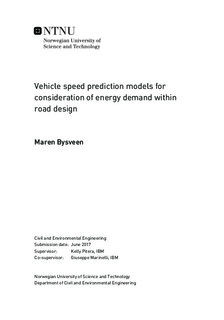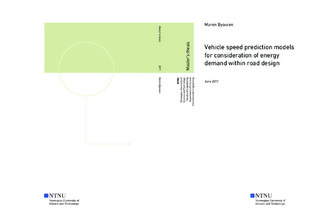| dc.description.abstract | The energy consumption within the transport sector was responsible for 23% of the world s total CO2 emissions in 2014, and road traffic was found to be the largest contributor both in Norway and Europe. This testifies a demand for reducing the energy consumption within the transport sector, and a necessity to be able to quantify and evaluate environmental impacts from new and existing road alignments in a realistic and accurate way.
The main motivation of this master thesis is to contribute to the development process of an innovative calculation module used to predict vehicle energy demand (Joule/km) along a road section. This is done through an evaluation of the performance of two existing, and mathematically different Norwegian speed prediction models for light vehicles, developed by SINTEF Technology and Society. Both are considered as possible speed models integrated in the future energy module. The EFFEKT speed model is a traditional regression speed model developed from average section speeds. The SINTEF speed model is expressed as an exponential function developed from the average of continuous speed profiles collected with GPS technology. The predicted speed profiles from both speed models are evaluated through linear regression related to the average of measured speeds along one direction of a two lane rural case road section in Norway.
Great effort has been made, nationally and internationally, allocated to research regarding speed prediction models. Unlike former research collecting speeds by manually performed measurements in the field, this study has applied speed data from a database provided by SINTEF Technology and Society. These were continuous speed profiles of high quality at no cost, collected with GPS technology.
Through use of the tools ArcGIS and MATLAB, the relevant data describing the geometry of the road and collected vehicle speeds along the case study section has been extracted from available databases and processed for further use within the analysis of the study.
The study results indicate good accordance between predicted speed and measured speed for both speed models. While the traditional regression speed model was found to make coarse simplifications of the changes within the speed affecting input variables, the speed model expressed as an exponential function have the ability to reflect such changes in a larger scale. The model characteristics of the speed model expressed as an exponential function is therefore recommended for future improvement and use within speed profile prediction models. | |

